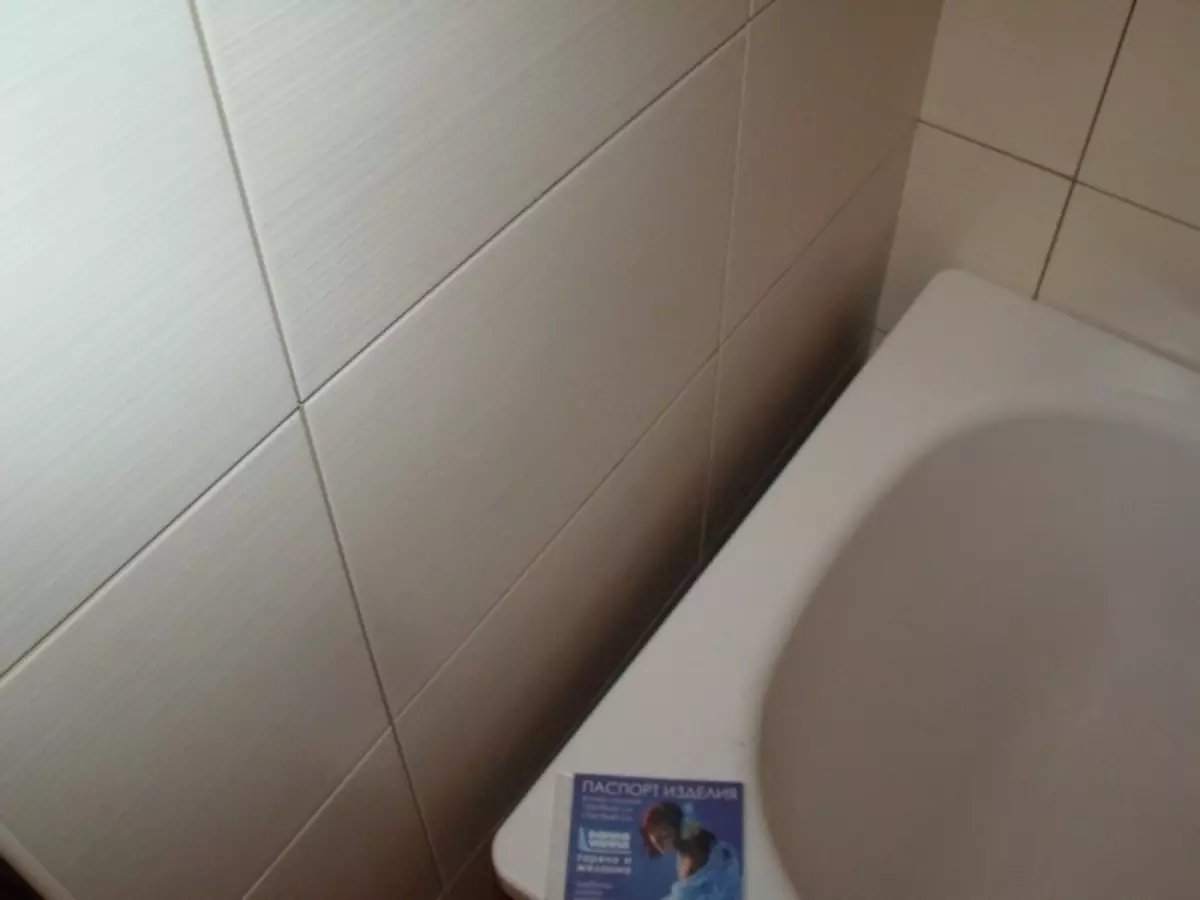
Even a small gap between the wall and the bath can cause major trouble. In the worst case, you will have to pay for repairs in the bathroom of the neighbors from the bottom, and in the best - to observe how the mold grows on your bathroom and different non-hypotic insects appear. You can avoid these consequences at the initial stage of repair, since the main reason for the appearance of the gap lies in uneven surfaces.
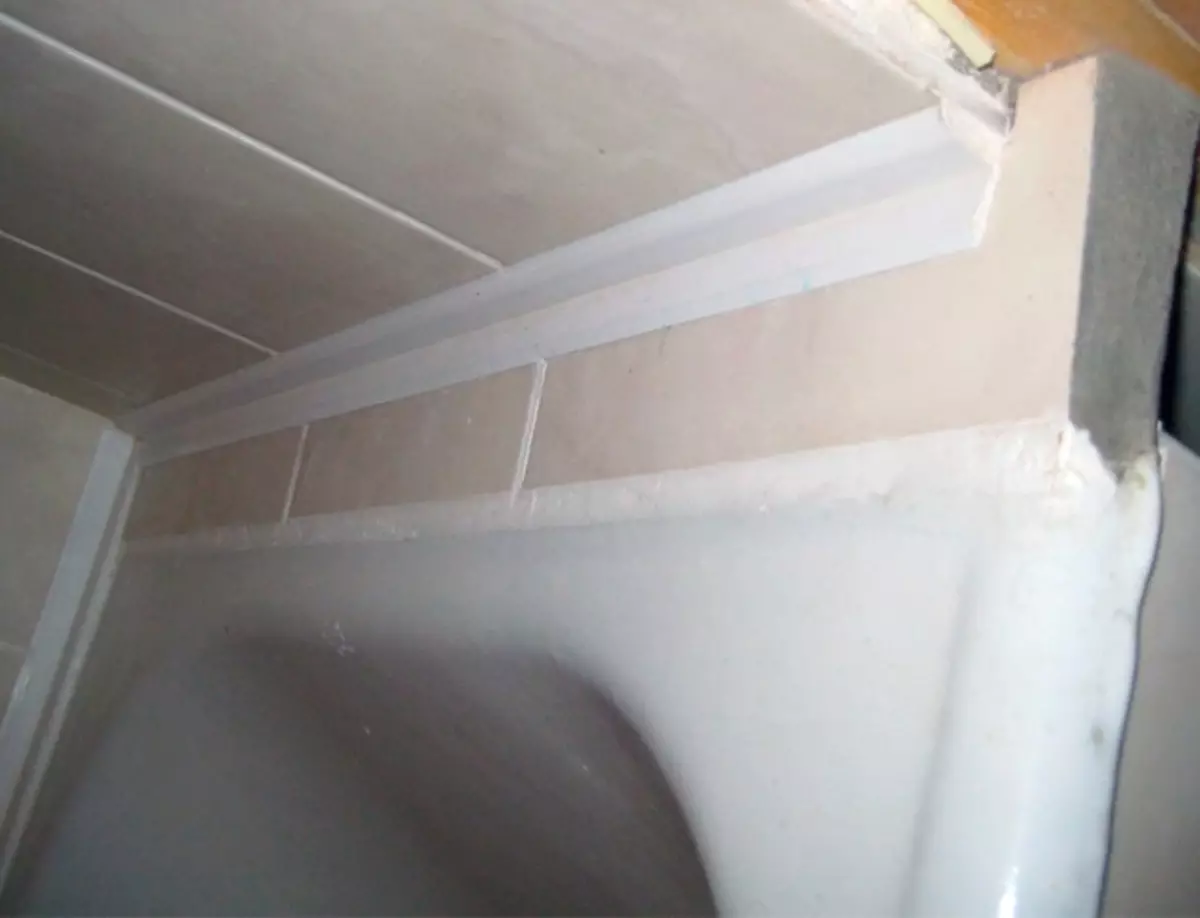
The reasons
Walls in the bathroom must be converged at an angle of 90 degrees, otherwise the clearance is inevitable. If during the repair process you noticed that the angle of convergence is wider than necessary, the walls must be aligned. It is also with the floor: it must be perfectly even.
It also happens that the bathroom itself is installed on the smooth floor. In this case, the situation can be corrected using regulated legs.

There is another reason for the appearance of the gap.
If the bath is shorter than the wall, along which it is installed, then the gap does not avoid.
In this case, you will have to either:
- Install an additional false wall of plasterboard;
- If the first option "eats" too much useful space, stamp the walls and install a longer bath.
However, if the repair has already been completed and there is no desire to dismantle the finish and start everything first, you can try to get rid of the gap of postfactum. In most cases, this is not difficult, you only need to choose the most suitable way.

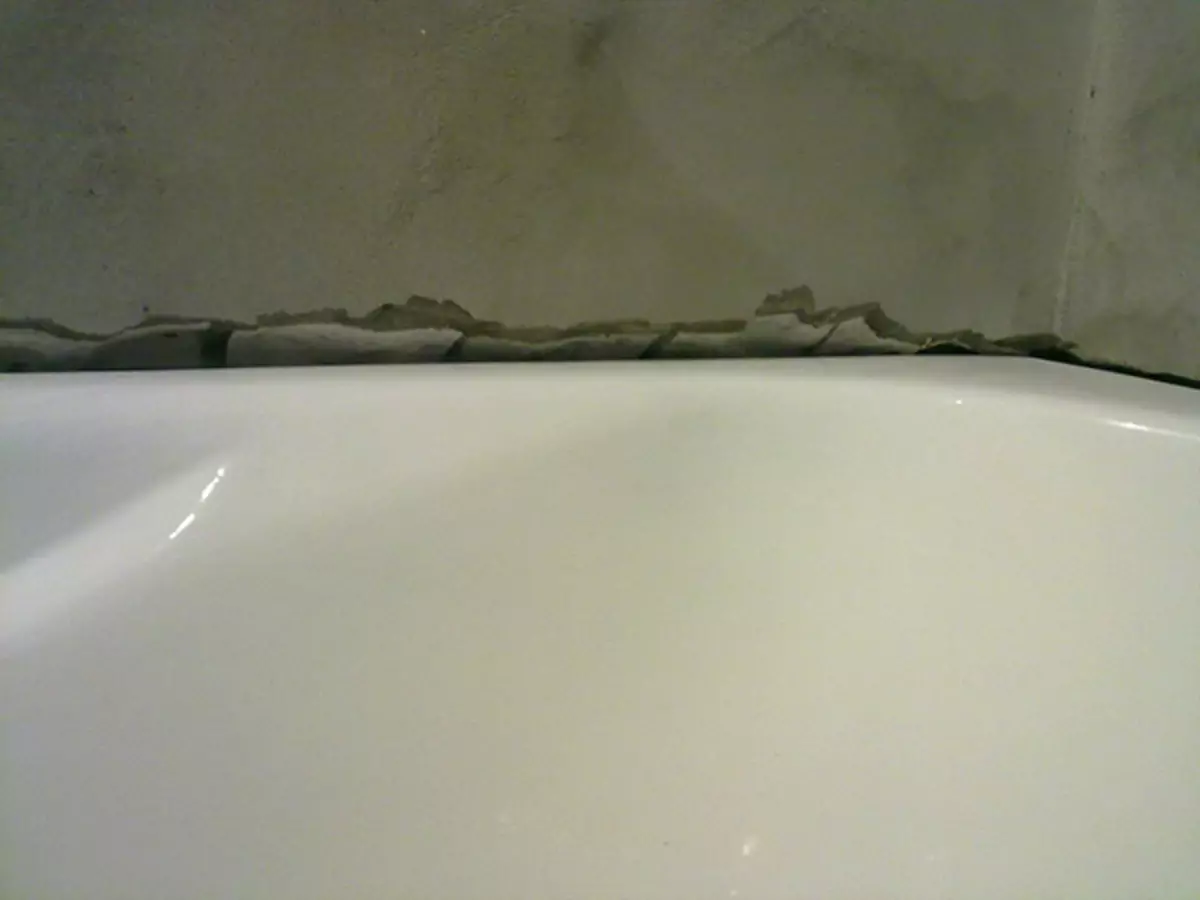
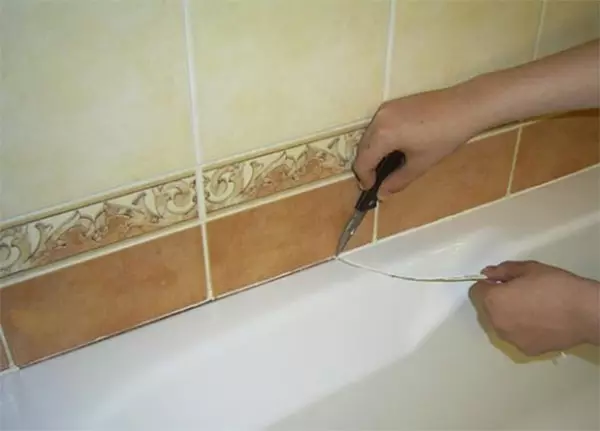
Scroll sealing solution
Cement mortar is an almost universal tool that can solve many household problems. This is one of the most reliable, but far from the most aesthetic decision, therefore, after all the work is completed, you will need to take care to Give an extinguished slit more aesthetic look:
- Clean the gap from dirt and mucus, if necessary, remove the old finish.
- Prepare the solution. When kneading, try to achieve a consistency of thick sour cream.
- Rate the size of the gap: if it is wide enough, the cement solution will spill on the floor. To avoid this, first impregnate old rags with a mixture and laid them the gap.

When the rag will dry a little, moisten the gap and start slowly and gently pour into it. Make sure that the outer part of the seam is obtained as already as possible.

The disguise method of the seam should be chosen based on the materials used to finish the walls. If it is a tile, then on the side you can lay out a border from its residues, preserved after repair. If these are plastic panels, then simply put on top of the seam of a border of plastic. If the walls are painted, then the same paint is filtering and seam, pre-slipped it.
Mounting foam
Faster, but no less universal than the cement solution The means is a mounting foam. With it, it is possible to close the gap between the wall and the bathroom can be in a matter of minutes. In contrast to the solution, the mounting foam can be laid only on a dry surface. Therefore, after you clean and degrease the clearance, blot it from the inside with dry wind and leave for a while dry.
Article on the topic: Glass winds in the interior

It is best to work in gloves, as the mounting foam is very poorly from the skin. And with all other surfaces, too, so, pouring her a gap, watch the splashes fall on the walls and bath.
To work in the bathroom, choose the moisture-proof mounting foam, this information is shown on the package.
Sequencing:
- Shake several times the balloon, insert the spout into the gap and start to pour carefully. Remember that as the foam dryer is very expanding, sometimes several dozen times, so do not try to fill the gap to the edges. Mounting foam dries about an hour.
- At the end of the time behind the time, cut the edge to dry the edges so that it is as smooth surface as possible.
- It is possible to disguise it by the same methods as in the previous case - facing tiles, a border of PVC or waterproof paint.
Sealant
The most modern agent is silicone sealant. There are a large selection of sealants designed for different use purposes. Among them, you need to find a sealant for the bathroom, since it has antibacterial substances that prevent the formation of mold. Sealants are of different colors, but we advise you to purchase a transparent, as the most universal option.
Sequencing:
- Remove the remains of building materials, dirt and mucus.
- Proceed the gap by degreasing solution, for example, alcohol or acetone and sweat dry.
- Open the spout on a tube with silicone sealant and fill out the gap of its contents using a mounting gun for this. From how the angle was cut off, it depends on what the width of the line will be obtained. The sharper the angle, the more it will be. Watch the line to be smooth and not interrupted.
- While the seam is not drying, firing it, shaking the finger with soapy solution.
- For greater aesthetics, seams can be disguised. About the way we told in detail above.
Article on the topic: Basic breakdowns of coffee machines
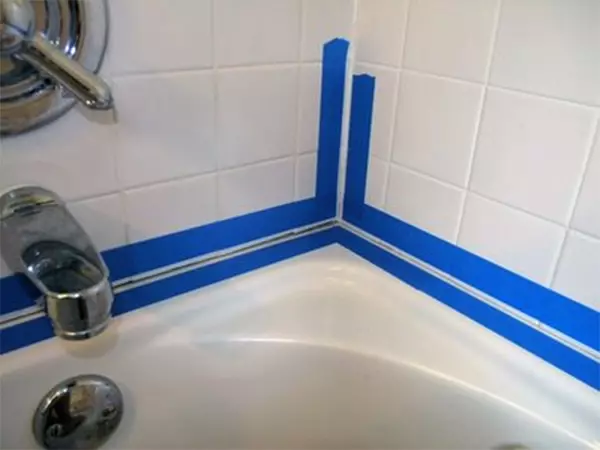
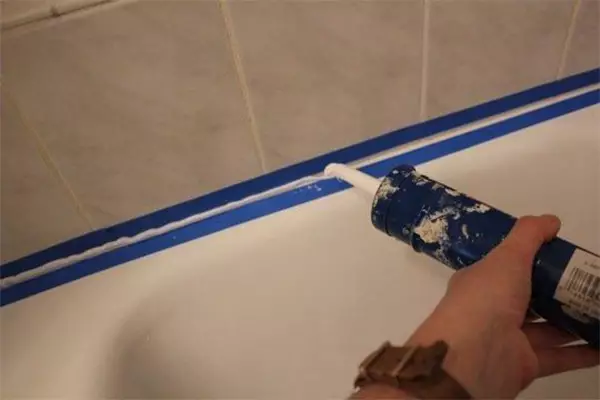
During the day after climbing the seam of silicone sealant, it is impossible to use the bathroom, otherwise all the work will be useless and seam will quickly come into disrepair ..
Plastic plinths
Plastic plinths - The most popular of all baseboards for the bathroom. They are successfully used to close the slit between the wall and the bathroom. PVC plinth can be easily and easily installed and just dismantled. In addition, plastic is a sufficiently soft and elastic material, so such a plinth can be easily adjusted under the size of the bath.
In stores you can find plastic plinths with an already ready adhesive basis. We do not recommend using them in the bathroom conditions, as the glue composition applied to them is usually not moisture-resistant. It is better to use waterproof glue, intended for plastic. It should be white, and even better - colorless. Be sure to choose quick-drying composition, since you will have to press the plinth until the glue is grabbing.
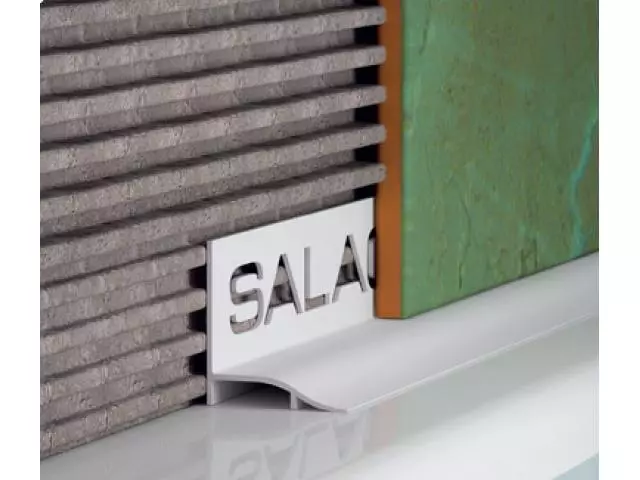
Sequencing:
- Remove, degrease and dry the gap.
- Make all the necessary measurements and trim the plinth at an angle of 45 degrees.
- Attach the plastic plinth to the joint of the bath with the wall, while without glue and stick the greasy tape to those parts of the wall and baths that are joined with it.
- Remove the plinth and lubricate the glue clearance.
- Fix the plinth on the spot and press it within a few minutes.
- After the adhesive composition is completely dry, you can spare tape.
- A plastic base jack with a wall must be treated with a bathroom sealant.
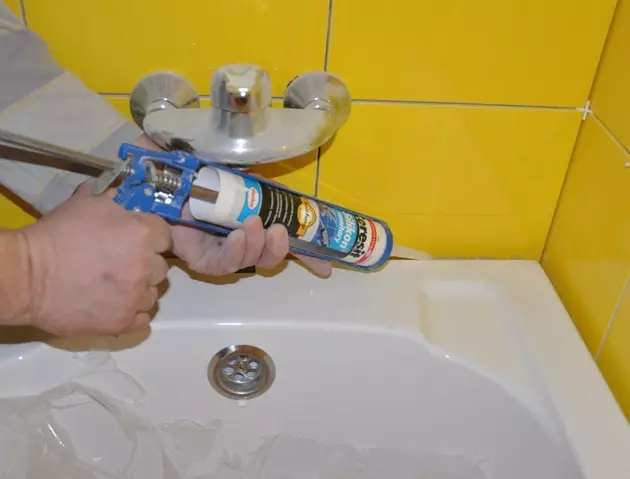
Burgundy ribbon.
Another inexpensive modern method that does not require much effort is the use of border tape. It is made of polypropylene and is impregnated with a special composition, which prevents the occurrence of mold.
Pros:
- does not require additional decoration;
- It is characterized by high water resistance, so it can be safely used in high humidity conditions.
The only drawback This method is that even the highest quality border tape will serve you no more than two years. But with active use of the bathroom, you will have to change it every year.
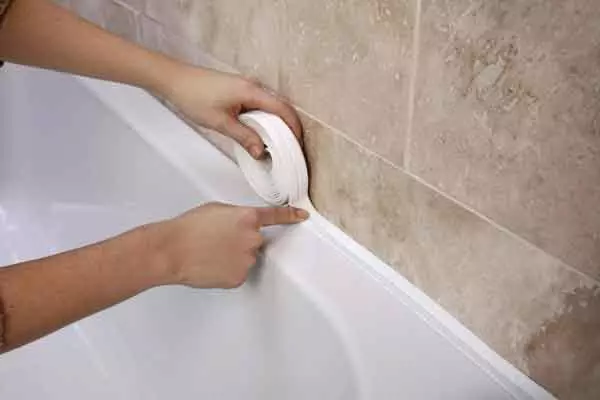
The width and thickness of the tape will depend on the size of the gap. Pre-punish, degreased and dried slit fill with colorless silicone sealant. Next, cut a piece of ribbon, appropriate size and apply liquid nails on it. Now you can glue the tape over the gap. You need to wait at least a day before starting to use the bathroom.
Article on the topic: Telescopic Bathroom Rod: Pros and Cons
Ceramic tile
All described above methods of getting rid of the gap between the wall and the border of the bath are suitable only if we are talking about a small gap, the width of which does not exceed 3 cm. If you are dealing with a wider cleft, you will have to be finished and put into the course of construction skills.
Close the gap using tile tiles. It is best to use the one that remained after the wall cladding. If after repairing anything left, simply acquire a white tile of suitable size, such that it is necessary to make a minimum of trimming. White tile will merge with a white bathroom, provided that it is white and therefore the border will be practically not visible. If you used a decorative curb in the walls of the walls, then you can arrange the joint with the same border.



We start with the preparatory work:
- If you can get under the bath, set directly under the wooden frame to prevent the cement mortar from entering the floor.
- If it is impossible, we close the gap with a rag, painted in solution, as in the first method.
- Fill the cement mortar into the gap and wait until it gets up.
- Then put the tile by adjusting the distance between fragments with special plastic crosses.
- A day later, process the seams suitable in color grout.
Combined junction sealing method
There are a huge set of junction sealing between the wall and the bathroom. Above we listed only standard solutions. But human imagination does not have a limit, so the network constantly appears a description of "folk" ways to get rid of this trouble. They offer both completely new solutions using original materials and methods that are a combination of those we talked about in this article.


Here is one of these combined ways:
- Pour the gap by mounting foam and give it to dry completely.
- Then you need to gently cut the surplus and smelting the seam with silicone sealant. This will make the surface more even and in addition will increase the water resistance of the design.
- After drying, the sealant is gluing on top of it a border ribbon. Thus, combined from three different ways, this method should be three times more reliable.
You can come up with your own method of solving this problem. Main requirements are waterproof and aesthetic appearance.
